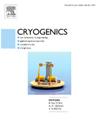超导磁体的二维机械表示:平面应力和平面应变的比较研究
IF 1.8
3区 工程技术
Q3 PHYSICS, APPLIED
引用次数: 0
摘要
在进行超导磁体的机械设计时,只要有可能,起始模型就是二维近似模型。如果存在旋转对称(类似螺线管的绕组),二维表示法是唯一的,不包含近似值。另一方面,如果选择非轴对称系统,则二维表示法并非唯一,主要有平面应力、带厚度的平面应力、平面应变和广义平面应变等选项。考虑到 z 是二维平面的法线方向,平面应力选项定义了一种应力状态,在这种状态下不会产生垂直于 xy 平面的法向应力或剪应力(σz=σxz=σyz=0)。相比之下,平面应变指的是变形只能在平面内发生,即不会发生平面外变形(ϵz=ϵxz=ϵyz=0)。平面应变选项通常适用于相对于横截面几乎无限长的结构,这些结构在载荷作用下的长度变化可以忽略不计。广义平面应变 "选项施加的轴向应变等于一个恒定值;这种情况无法再现磁体的实际运行状况,因此不在计算之列。有厚度的平面应力 "使用与平面应力选项相同的方程,但输出量是以厚度定义的单位长度给出的;因此,它再次被排除在比较之外。超导磁体(如偶极子)并不完全符合上述任何一种方案:它们远非很薄,但在载荷作用下会发生纵向变形。本研究报告以偶极子磁体为具体案例,对平面应力和平面应变进行了比较研究。本文章由计算机程序翻译,如有差异,请以英文原文为准。
2D mechanical representation of superconducting magnets: A comparative study of plane stress and plane strain
When approaching the mechanical design of a superconducting magnet, whenever possible the starting model is a 2D approximation. If rotational symmetry (solenoid-like winding) is present, the 2D representation is unique and contains no approximations. If, on the other hand, a non-axisymmetric system is opted for, the 2D representation is not unique and there are main options available, as plane stress, plane stress with thickness, plane strain and generalized plane strain. Considering z as the direction normal to the 2D plane, the plane stress option defines a stress state in which no normal or shear stresses perpendicular to the xy plane can occur (). In this option, deformation can occur in the thickness direction of the element, which will become thinner when stretched and thicker when compressed; it is generally used for objects with limited depth (thin objects).
In contrast, plane strain refers to the fact that deformation can only occur in plane, which means that no out-of-plane deformation will occur (). The plane strain option is generally appropriate for structures of nearly infinite length, relative to their cross section, that exhibit negligible length changes under load. The “generalized plane strain” option imposes the axial strain equal to a constant value; this condition does not reproduce the real operating condition of the magnet and is therefore excluded. The “plane stress with thickness” uses the same equations as the plane stress option but, output quantities are given per unit length defined with thickness; therefore, it is again excluded from the comparison. Superconducting magnets, such as dipoles, do not fit neatly into any of the above options: they are far from thin but deform longitudinally under load. This work reports a comparative study of plane stress and plane strain in the specific case study of a dipole magnet.
求助全文
通过发布文献求助,成功后即可免费获取论文全文。
去求助
来源期刊

Cryogenics
物理-热力学
CiteScore
3.80
自引率
9.50%
发文量
0
审稿时长
2.1 months
期刊介绍:
Cryogenics is the world''s leading journal focusing on all aspects of cryoengineering and cryogenics. Papers published in Cryogenics cover a wide variety of subjects in low temperature engineering and research. Among the areas covered are:
- Applications of superconductivity: magnets, electronics, devices
- Superconductors and their properties
- Properties of materials: metals, alloys, composites, polymers, insulations
- New applications of cryogenic technology to processes, devices, machinery
- Refrigeration and liquefaction technology
- Thermodynamics
- Fluid properties and fluid mechanics
- Heat transfer
- Thermometry and measurement science
- Cryogenics in medicine
- Cryoelectronics
 求助内容:
求助内容: 应助结果提醒方式:
应助结果提醒方式:


